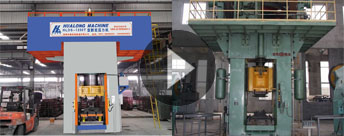Common Pitfalls and Misunderstandings to Avoid When Purchasing a Powder Molding Press
Author: haloong Time: 2025-05-20 14:10:00
Investing in a powder molding press is a critical decision that directly impacts production efficiency, product quality,
and long-term operational costs. However, buyers often fall into common traps or harbor misunderstandings during the
purchasing process, leading to suboptimal choices. This article highlights key pitfalls to avoid and provides actionable
insights to guide informed decision-making.
Pitfall 1: Prioritizing Price Over Quality
Many buyers focus excessively on upfront costs while neglecting the long-term implications of equipment quality. A cheaper
press may seem appealing initially, but low-quality machines often suffer from unstable performance, frequent breakdowns,
and higher maintenance expenses. Over time, these issues can erode cost savings and disrupt production schedules.
Recommendation: Evaluate the total cost of ownership (TCO), including durability, energy efficiency, and after-sales support.
Opt for reputable manufacturers with proven reliability, even if their prices are slightly higher.
Pitfall 2: Overlooking Machine Applicability
Not all powder molding presses are suited for every application. Purchasing a generic machine without considering specific
production requirements—such as material type, part complexity, or desired output capacity—can result in inefficiencies or
defective products. For example, a press designed for soft metal powders might fail to handle high-density ceramics effectively.
Recommendation: Clearly define your production needs (e.g., pressure range, mold compatibility, automation level) and consult
technical experts to select a press tailored to your use case.
Pitfall 3: Ignoring Technological Upgrades and Maintenance
Technology in powder molding evolves rapidly, with advancements in automation, precision control, and energy efficiency.
Buyers who overlook upgradability may find their equipment obsolete within a few years, incurring costly replacements.
Similarly, neglecting maintenance requirements can lead to unexpected downtime.
Recommendation: Choose a press with modular designs that allow future upgrades (e.g., IoT integration, improved hydraulics).
Prioritize suppliers offering comprehensive maintenance plans and spare parts availability.
Pitfall 4: Falling for Overhyped Marketing Claims
Sales pitches or advertisements may exaggerate capabilities, such as claiming a single press can handle "any material" or "
unmatched productivity." Such claims often mask limitations. Blindly trusting these promises can lead to mismatched equipment
and unmet expectations.
Recommendation: Request real-world case studies or onsite demonstrations. Validate claims through third-party reviews or
industry references.
Conclusion
A powder molding press is a long-term investment, and avoiding these pitfalls requires a balanced approach. Prioritize quality
and suitability over short-term savings, plan for technological adaptability, and verify supplier claims rigorously. By doing so,
manufacturers can ensure optimal performance, reduced downtime, and sustained competitiveness in their operations.
Key Takeaway: A well-informed purchase decision hinges on aligning technical specifications with production goals, valuing
reliability over initial cost, and fostering partnerships with trustworthy suppliers.






